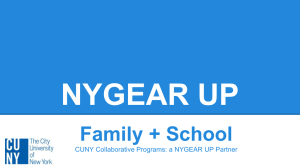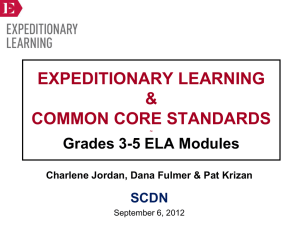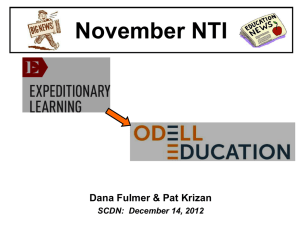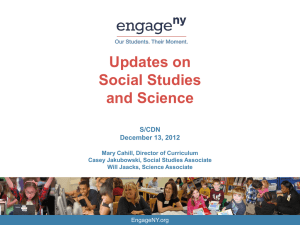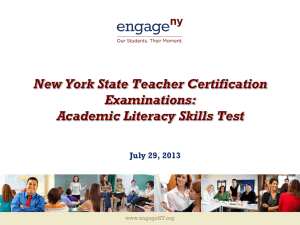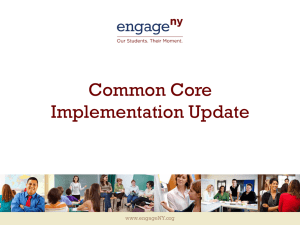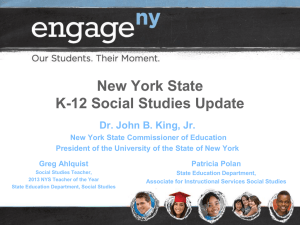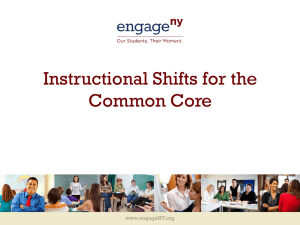ELA DDI Presentation
advertisement
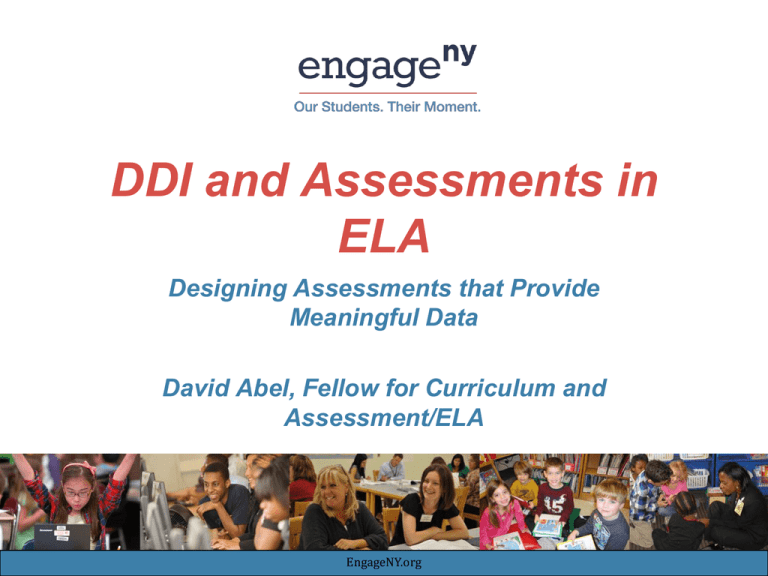
DDI and Assessments in ELA Designing Assessments that Provide Meaningful Data David Abel, Fellow for Curriculum and Assessment/ELA EngageNY.org Session Objectives We will learn… • About the elements of a high-quality Common Core-aligned ELA assessment • How to create and choose assessment tasks that are rigorous, measure the standards and give comprehensive information about students at all levels Engageny.org Why do we assess…? Engageny.org Let’s begin… Take 10 minutes to read the 6th grade passage (Sweet Science Comes Baked In), annotated test item, and student work samples 1-3 and answer this question … Given the standard the question is measuring, what can we say we know about the students in student responses #1-3? Engageny.org The question • MEASURES CCSS RI.6.5: Analyze how a particular sentence, paragraph, chapter, or section fits into the overall structure of a text and contributes to the development of the ideas. • HOW THIS QUESTION MEASURES RI.6.5: This question measures RI.6.5 because it asks students to analyze how a particular sentence fits into the overall structure and meaning of the text. More than one response may be correct, but a correct response will focus on Morgan’s background and family experience with baking science, as well as her aspirations. Engageny.org Student Response #1 • What do we know about this student, based on this response? • What DON’T we know about based on this response? Engageny.org Student Response #2 • What do we know about this student, based on this response? • What DON’T we know about based on this response? Engageny.org Student Response #3 • What do we know about this student, based on this response? • What DON’T we know about based on this response? Engageny.org The Known Unknown When working with openresponse questions that require COMPREHENSION and ANALYSIS as demanded by the standards, student responses such as #1 and, to an extent, #3 do not give you information about whether students didn’t perform well because they couldn’t meet the demands of the standard or because they couldn’t comprehend the complex text. Engageny.org “... there are known knowns; there are things we know that we know. There are known unknowns; that is to say, there are things that we now know we don't know. But there are also unknown unknowns – there are things we do not know we don't know.” The formative assessment advantage • Formative assessments can yield student work that gives richer information, given that they can be administered Without the same time constraints/pressure that accompany the 3-8 ELA test In a manner that connects directly to targeted instruction Engageny.org Common Core-aligned ELA assessment • What are the elements of a high-quality Common Core-aligned ELA assessment? The CCSS for ELA/Literacy require comprehension, analysis and communication (writing/speaking) using evidence from text(s) Open response writing items and/or performance tasks are the types of assessment questions that best provide a means for communication using evidence from text(s) Engageny.org Common Core-aligned ELA assessment Grade-level standards add specific demands to the skills and knowledge of students on track for college and careers Therefore, given the emphasis on textual evidence and the specific demands of grade-level standards, you need to use texts that can support measurement of the grade-level standards. Example: CCSS.ELA-Literacy.RI.7.6 Determine an author’s point of view or purpose in a text and analyze how the author distinguishes his or her position from that of others. Engageny.org TEXT SELECTION IS THE FOUNDATION OF CCSS ELA ASSESSMENT Texts at grade-level complexity Questions that measure the CCSS Rubrics to evaluate student work Engageny.org Or to put it another way… • The crucial components of CCSS ELA assessment are: Texts that can support questions that measure the CCSS Questions that measure the CCSS Rubrics that give you good and actionable info about student performance Engageny.org Selecting texts • 3-8 Assessment design documents begin on page 9 of your packet and include: Passage selection guidelines New York State Passage Selection Resources for Grade 3‐8 Assessments Engageny.org Features of a Complex Text • • • • • • • • Subtle and/or frequent transitions • • Longer paragraphs Multiple and/or subtle themes and purposes Density of information Unfamiliar settings, topics or events Lack of repetition, overlap of similarity in words and sentences Complex sentences Uncommon vocabulary Lack of words, sentences or paragraphs that review or pull things together for the student Any text structure which is less narrative and/or mixes structures EngageNY.org Engageny.org Take out your Homework… • Does the text you used in your assessment meet the demands articulated in these review docs? • How about text #1? #2? • Which text would be better to measure the CCLS as articulated on pages 16-30? • Discuss with a partner Engageny.org Questions that measure the CCSS • Extended Response types measure CCSS Writing Standards (W1, 2) CCSS Writing standards integrate Reading and Language Standards (W5, W9) • Short response types Claim + evidence • Claim = statement of comprehension/analysis required by the standard • Evidence = proof of comprehension/analysis required by the standard Engageny.org Questions that measure the CCSS • Claim + evidence short response questions Depending on the text, you can progress through the reading standards … • from high-level comprehension/what is a central idea of this text/(R2) … • to the more granular (R2-3)… • to craft and structure (R4-6)… • and, if using multiple texts, integration of knowledge and ideas (R7-9)… • All requiring a set number of details (at least 2) in support of the claim. Once in this place, you can build on this to assess other standards (Writing, S&L, Language) with extended response questions and performance tasks Engageny.org Questions that measure the CCSS How to write these questions? Don’t do the analyzing for the kids in your efforts to be specific, but... Don’t be so broad that nearly anything (or almost nothing) answers the question! Engageny.org Questions that measure the CCSS Examples: (using Text #1) How does the author's perspective build suspense for the reader? How does the author support the idea that the narrator felt “detached” from his injured leg? Non-examples: (using Text #1) How would you feel if you were in this situation? What would you do? How does the accident result in "an uncrossable gap” between the climbers? Engageny.org Take out your Homework… • Do your questions measure the CCSS(pages 16-30) ? • Do they provide actionable information about student ability to comprehend and analyze complex texts? • What are the strengths or weaknesses of your questions? Discuss with a partner. Engageny.org Rubrics • Form follows function! How much information do you need? • Do you want a quick view of the student’s ability to display comprehension and analysis and mostly measure reading standards? Go holistic a la short response rubric • Do you want to measure an extended writing assignment that can measure the reading, writing, and language standards? Use the extended response rubric and get granular. Sample rubrics on page 43-45 Engageny.org Return to the student work packet…and student #1 • Next steps could be: Referring to an earlier close reading lesson/unit in which scaffolded instruction has happened targeting and assessing that standard • If the student struggled with the culminating assessment aligned to that standard, then it is possible the student is struggling with the standard • If the student performed well on the assessment, then it is possible that the student is struggling with comprehension of complex text Engageny.org Return to the student work packet…and student #1 • Next steps could be: Administering an assessment targeting the same standards via a read aloud to see if the student can meet the standard via speaking and listening • Students who are not reading on grade level are often capable of making inferences and conducting sophisticated analyses! Targeted skills and comprehension strategy work with differentiated groups, followed by claim and evidence style questions to monitor comprehension • Students’ reading levels must be built up, via targeted interventions and a volume of independent reading. Engageny.org But! But you will need to make time to overwhelm the problem! Without this the data will just tell you what you may already know….running in place. Engageny.org Partner Practice • With a neighbor, think about how you might need to adjust your assessment with students who are struggling to comprehend grade-level complex texts? Do you need to select a new text? Revise the questions? Both? What else can you do to get good data? Engageny.org SUMMING UP • Text selection matters • The standards can not be met without comprehension • This is challenging and time-consuming…But worth it! Engageny.org THANK YOU David Abel dabel@mail.nysed.gov https://www.engageny.org/3-8 https://www.engageny.org/resource/regentsexams Engageny.org
